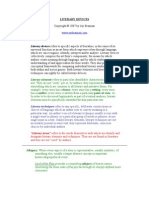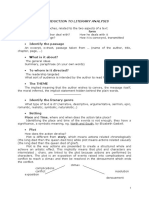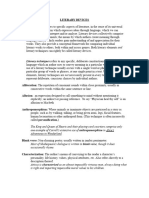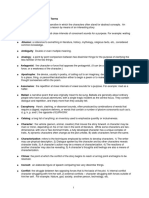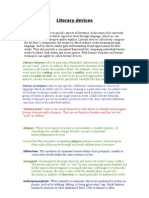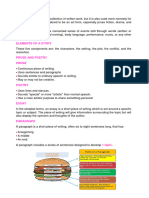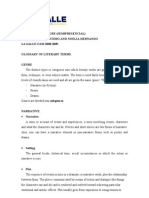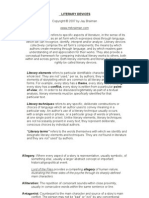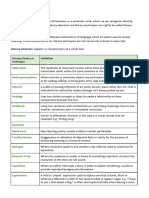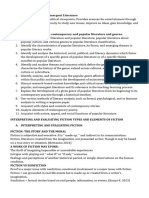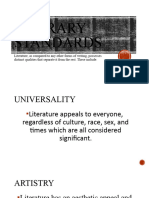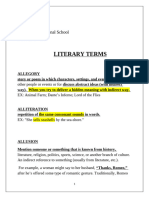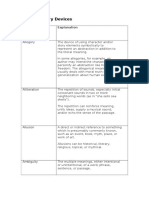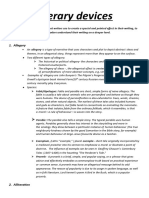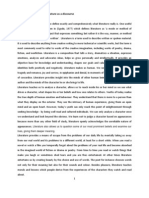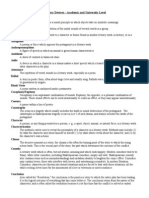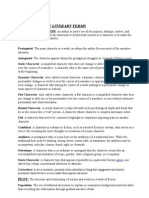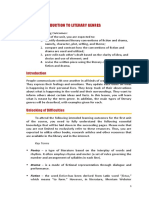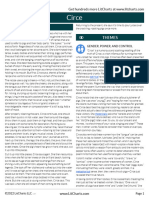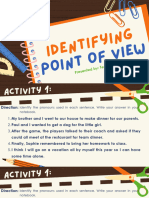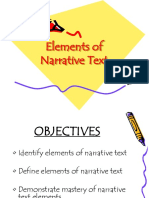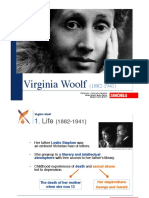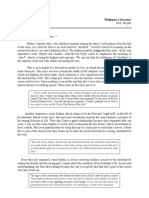2019-2020 AP Lit Terms.docx
2019-2020 AP Lit Terms.docx
Uploaded by
Michelle LiewCopyright:
Available Formats
2019-2020 AP Lit Terms.docx
2019-2020 AP Lit Terms.docx
Uploaded by
Michelle LiewCopyright
Available Formats
Share this document
Did you find this document useful?
Is this content inappropriate?
Copyright:
Available Formats
2019-2020 AP Lit Terms.docx
2019-2020 AP Lit Terms.docx
Uploaded by
Michelle LiewCopyright:
Available Formats
AP LITERARY TERMS
ALLEGORY story or poem in which characters, settings, and events stand for other people or events or for
abstract ideas or qualities.
EXAMPLE: Animal Farm; Dante’s Inferno; Lord of the Flies
ALLITERATION repetition of the same or similar consonant sounds in words that are close together.
EXAMPLE: “When the two youths turned with the flag they saw that much of the regiment had
crumbled away, and the dejected remnant was coming slowly back.” –Stephen Crane (Note how
regiment and remnant are being used; the regiment is gone, a remnant remains…)
ALLUSION reference to someone or something that is known from history, literature, religion, politics, sports,
science, or another branch of culture. An indirect reference to something (usually from literature, etc.).
AMBIGUITY ambiguity, or fallacy of ambiguity, is a word, phrase, or statement which contains more than one
meaning. Ambiguous words or statements lead to vagueness and confusion, and shape the basis for instances of
unintentional humor.
ANTAGONIST Opponent who struggles against or blocks the hero, or protagonist, in a story.
ANTHESIS literally means “opposite,” is a rhetorical device in which two opposite ideas are put together in a
sentence to achieve a contrasting effect. Antithesis emphasizes the word in the same line. An antithesis is a
figure of speech that refers to the juxtaposition of opposing or contrasting ideas.
ANTECEDENT an earlier clause, phrase, or word to which a pronoun, noun, or another word refers. Broadly
speaking, antecedent is a literary device in which a word or pronoun in a line or sentence refers to an earlier
word. For instance, “While giving treats to children or friends offer them whatever they like.” In this line,
children and friends are antecedents, while they is a pronoun that refers to friends and children. It is a typical
linguistic term and originates from grammar.
ANTIHERO Central character who lacks all the qualities traditionally associated with heroes. may lack
courage, grace, intelligence, or moral scruples.
ARCHETYPES - An archetype, also known as “universal symbol,” may be a character, a theme, a symbol, or
even a setting. Many literary critics are of the opinion that archetypes – which have a common and recurring
representation in a particular human culture, or entire human race – shape the structure and function of a literary
work.
ARCHETYPAL (CHARACTER) – a character that seems to represent universal patterns of human nature.
CATHARSIS an emotional discharge through which one can achieve a state of moral or spiritual renewal, or
achieve a state of liberation from anxiety and stress protagonist cannot avoid, usually occurring as a result of his
hubris. Catharsis – feelings of pity and fear felt by the audience, for the inevitable downfall of the protagonist
CHARACTERIZATION the process by which the writer reveals the personality of a character.
Literary Terms page 1
INDIRECT CHARACTERIZATION the author reveals to the reader what the character is like by
describing how the character looks and dresses, by letting the reader hear what the character says, by
revealing the character’s private thoughts and feelings, by revealing the characters effect on other people
(showing how other characters feel or behave toward the character), or by showing the character in
action. Common in modern literature
DIRECT CHARACTERIZATION the author tells us directly what the
character is like: sneaky, generous, mean to pets and so on. Romantic style literature relied more
heavily on this form.
STATIC CHARACTER is one who does not change much in the course of a story.
DYNAMIC CHARACTER is one who changes in some important way as a result of the story’s
action.
FLAT CHARACTER has only one or two personality traits. They are one dimensional, like a piece of
cardboard. They can be summed up in one phrase.
ROUND CHARACTER has more dimensions to their personalities---they are complex, just a real
people are.
COMEDY in general, a story that ends with a happy resolution of the conflicts faced by the main character or
characters.
CONCEIT a figure of speech in which two vastly different objects are likened together with the help of similes
or metaphors. Conceit develops a comparison which is the unquestionable. Metaphysical texts offer
comparisons of unlikely things and are loaded with conceits, paradoxes, irony, and They are argumentative,
intellectual, realistic and rational in their approach.
CONFLICT the struggle between opposing forces or characters in a story.
EXTERNAL CONFLICT conflicts can exist between two people, between a person and nature or a
machine or between a person a whole society.
INTERNAL CONFLICT a conflict can be internal, involving opposing forces within a person’s mind.
DIALECT a way of speaking that is characteristic of a certain social group or of the inhabitants of a certain
geographical area.
DICTION a speaker or writer’s choice of words.
DIDACTIC form of fiction or nonfiction that teaches a specific lesson or moral or provides a model of correct
behavior or thinking.
EPIPHANY In literary terms, an epiphany is that moment in the story where a character achieves realization,
awareness, or a feeling of knowledge, after which events are seen through the prism of this new light in the
story.
Literary Terms page 2
EXPLICATION act of interpreting or discovering the meaning of a text, usually involves close reading and
special attention to figurative language.
FABLE a very short story told in prose or poetry that teaches a practical lesson about how to succeed in life.
FARCE a type of comedy in which ridiculous and often stereotyped characters are involved in silly, far-
fetched situations.
FIGURATIVE LANGUAGE Words which are inaccurate if interpreted literally, but are used to describe.
Similes and metaphors are common forms.
FLASHBACK a scene that interrupts the normal chronological sequence of events in a story to depict
something that happened at an earlier time.
FOIL A character who acts as contrast to another character. Often a funny side kick to the dashing hero, or a
villain contrasting the hero.
FORESHADOWING the use of hints and clues to suggest what will happen later in a plot.
IMAGERY the use of language to evoke a picture or a concrete sensation of a person , a thing, a place, or an
experience.
SENSORY IMAGERY any description that involves one or more of the five senses -- touch, sight,
taste, smell and sound. Poetry that is rich in sensory detail helps the reader perfectly envision the scene
the poet is describing. "I walked in the grass" becomes rich in sensory detail when changed to, "The
charred scent of the crisp, freshly-burned grass stabbed my nose as it crumbled under my feet."
Adjectives play a prime role in developing sensory imagery, but some adjectives are better than others.
Stating that grass is green helps the reader picture the color, but explaining the hue of green or
comparing the color to another color can make the image more vivid.
PASTORAL IMAGERY a literary work (such as a poem or play) dealing with shepherds or rural life
in a usually artificial manner and typically drawing a contrast between the innocence and serenity of the
simple life and the misery and corruption of city and especially court life.
IN MEDIAS RES (Latin: “in the midst of things”) the practice of beginning an epic or other narrative by
plunging into a crucial situation that is part of a related chain of events; the situation is an extension of previous
events and will be developed in later action.
IRONY a discrepancy between appearances and reality.
VERBAL IRONY occurs when someone says one thing but really means something else.
SITUATIONAL IRONY takes place when there is a discrepancy between what is expected to happen,
or what would be appropriate to happen, and what really does happen.
Literary Terms page 3
DRAMATIC IRONY is so called because it is often used on stage. A character in the play or story
thinks one thing is true, but the audience or reader knows better.
JUXTAPOSITION poetic and rhetorical device in which normally unassociated ideas, words, or phrases are
placed next to one another, creating an effect of surprise and wit. Ezra Pound: “The apparition of these faces in
the crowd;/ Petals on a wet, black bough.” Juxtaposition is also a form of contrast by which writers call
attention to dissimilar ideas or images or metaphors.
Martin Luther King: “Injustice anywhere is a threat to justice everywhere.”
LOCAL COLOR a term applied to fiction or poetry which tends to place special emphasis on a particular
setting, including its customs, clothing, dialect and landscape.
METAPHOR – EXTENDED METAPHOR An extended metaphor is a metaphor that is developed in great
detail. The amount of detail can vary from that of a sentence or a paragraph, to encompassing an entire work. In
an extended metaphor, the author takes a single metaphor and employs it at length, using various subjects,
images, ideas and situations. They are commonly used in poetry, as well as prose.
MOOD An atmosphere created by a writer’s diction and the details selected.
MOTIF a recurring image, word, phrase, action, idea, object, or situation used throughout a work (or in several
works by one author), unifying the work by tying the current situation to previous ones, or new ideas to the
theme. Kurt Vonnegut uses “So it goes” throughout Slaughterhouse-Five to remind the reader of the
senselessness of death.
OXYMORON a figure of speech that combines opposite or contradictory terms in a brief phrase. “Jumbo
shrimp.” “Pretty ugly.” “Bitter-sweet”
PARABLE a relatively short story that teaches a moral, or lesson about how to lead a good life.
PARADOX a statement that appears self-contradictory, but that reveals a kind of truth.
KOAN is a paradox used in Zen Buddhism to gain intuitive knowledge: “What is the sound of one hand
clapping?”
PARODY a work that makes fun of another work by imitating some aspect of the writer’s style.
PERSONIFICATION a figure of speech in which an object or animal is given human feelings, thoughts, or
attitudes.
PLOT the series of related events in a story or play, sometimes called the storyline.
Characteristics of PLOT:
EXPOSITION introduces characters, situation, and setting
Literary Terms page 4
RISING ACTION complications in conflict and situations (may introduce new ones as well)
CLIMAX that point in a plot that creates the greatest intensity, suspense, or interest. Also called
“turning point”
RESOLUTION the conclusion of a story, when all or most of the conflicts have been settled; often
called the denouement.
POINT OF VIEW the vantage point from which the writer tells the story.
FIRST PERSON POINT OF VIEW one of the characters tells the story.
THIRD PERSON POINT OF VIEW an unknown narrator, tells the story, but this narrator zooms in
to focus on the thoughts and feelings of only one character.
OMNISCIENT POINT OF VIEW an omniscient or all knowing narrator tells the story, also using the
third person pronouns. This narrator, instead of focusing on one character only, often tells us
everything about many characters.
OBJECTIVE POINT OF VIEW a narrator who is totally impersonal and objective tells the story,
with no comment on any characters or events.
PROTAGONIST the central character in a story, the one who initiates or drives the action. Usually the hero
or anti-hero; in a tragic hero, like John Proctor of The Crucible, there is always a hamartia, or tragic flaw in
his character which will lead to his downfall.
PUN a “play on words” based on the multiple meanings of a single word or on words that sound alike but mean
different things.
REFERENT the concrete object or concept that is designated by a word or expression. A referent is an object,
action, state, relationship, or attribute in the referential realm. Historically, there was only one person called
George Washington, the first president of the United States. He can be referred to in a text in many ways, such
as
the president
Mr. Washington
he, or even
my friend.
Even though there are many ways to talk about him, there is only one referent in the referential realm.
ROMANCE in general, a story in which an idealized hero or heroine undertakes a quest and is successful.
Literary Terms page 5
SATIRE a type of writing that ridicules the shortcomings of people or institutions in an attempt to bring about
a change.
STEREOTYPE a fixed idea or conception of a character or an idea which does not allow for any individuality,
often based on religious, social, or racial prejudices.
STREAM OF CONSCIOUSNESS a style of writing that portrays the inner (often chaotic) workings of a
character’s mind.
STYLE the distinctive way in which a writer uses language: a writer’s distinctive use of diction, tone, and
syntax.
SUSPENSE a feeling of uncertainty and curiosity about what will happen next in a story.
SYMBOL a person, place, thing, or event that has meaning in itself and that also stands for something more
than itself.
SYNECDOCHE a figure of speech in which a part represents the whole. “If you don’t drive properly, you
will lose your wheels.” The wheels represent the entire car.
SYNTAX the way in which words and sentences are placed together. Usually in the English language the
syntax should follow a pattern of subject-verb-object agreement but sometimes authors play around with this to
achieve a lyrical, rhythmic, rhetoric or questioning effect. It is not related to the act of choosing specific words
or even the meaning of each word or the overall meanings conveyed by the sentences.
TALL TALE an outrageously exaggerated, humorous story that is obviously unbelievable.
THEME the insight about human life that is revealed in a literary work.
TONE the attitude a writer takes toward the subject of a work, the characters in it, or the audience, revealed
through diction, figurative language, and organization.
TRAGEDY in general, a story in which a heroic character either dies or comes to some other unhappy end.
UNDERSTATEMENT a statement that says less than what is meant.
Example: During the second war with Iraq, American troops complained of a fierce sand storm that
made even the night-vision equipment useless. A British commando commented about the storm: “It’s a
bit breezy.”
UNITY Unified parts of the writing are related to one central idea or organizing principle. Unity is dependent
upon coherence.
VERNACULAR the language spoken by the people who live in a particular locality.
Literary Terms page 6
Literary Terms page 7
You might also like
- Literary Elements For Literature PDFDocument8 pagesLiterary Elements For Literature PDFHidayah Roslee100% (2)
- Inspired 3D Short Film Production - Character Development and DesignDocument41 pagesInspired 3D Short Film Production - Character Development and Designzeynab seyfiNo ratings yet
- English Test For Grade 8 With AnswersDocument2 pagesEnglish Test For Grade 8 With AnswersTIANA ARILE75% (4)
- Literary DevicesDocument29 pagesLiterary DevicesvolhenryNo ratings yet
- Vocabulary For Literary AnalysisDocument7 pagesVocabulary For Literary AnalysisLexie TrầnNo ratings yet
- Literary TermsDocument7 pagesLiterary Termssulo444No ratings yet
- Cambridge Learner Guide For Igcse First Language EnglishDocument32 pagesCambridge Learner Guide For Igcse First Language Englishnikitsa100% (2)
- Literary Terms Page 1Document8 pagesLiterary Terms Page 1Taryn BrightNo ratings yet
- AP Literary TermsDocument11 pagesAP Literary Termsshauna2122100% (1)
- Terms of Concepts Related To Terms of Literary AnalysisDocument15 pagesTerms of Concepts Related To Terms of Literary AnalysisnanicastlNo ratings yet
- Literary_DevicesDocument8 pagesLiterary_Devicesyejinha0130No ratings yet
- Lesson 3: Literary Elements and DevicesDocument2 pagesLesson 3: Literary Elements and DevicesTan AlmoguerraNo ratings yet
- Introduction To Literary AnalysisDocument4 pagesIntroduction To Literary Analysisbilly dawnNo ratings yet
- Literary Devices PDFDocument8 pagesLiterary Devices PDFJean Carlos Vicente RiveraNo ratings yet
- Literature Term Glossary PDFDocument4 pagesLiterature Term Glossary PDFnisaNo ratings yet
- Literary DevicesDocument8 pagesLiterary Devicescwittesaele_20117686100% (3)
- Literary Terms HandbookDocument9 pagesLiterary Terms HandbookDevDusaneNo ratings yet
- RespuestasDocument12 pagesRespuestasromantico7w7No ratings yet
- Novel Major TermsDocument8 pagesNovel Major TermsSamar GujjarNo ratings yet
- Literature Through The AgesDocument65 pagesLiterature Through The Agesjuvy ann bagatilaNo ratings yet
- Literary DevicesDocument7 pagesLiterary DevicesArgie Ray Ansino ButalidNo ratings yet
- Forms & Division of Literature, PoetryDocument15 pagesForms & Division of Literature, PoetryDranyl Eve VenturaNo ratings yet
- LITERARY DEVICES and APPROACHES-1Document32 pagesLITERARY DEVICES and APPROACHES-1HU11A2 - Jan Conrad B. AdaneNo ratings yet
- Glossary of Literary TermsDocument11 pagesGlossary of Literary Termsmibasura100% (1)
- Glossary of Literary TermsDocument6 pagesGlossary of Literary Termsaakritib_4No ratings yet
- Literary Elements Refers To Particular Identifiable Characteristics of ADocument9 pagesLiterary Elements Refers To Particular Identifiable Characteristics of ANurul IffahNo ratings yet
- English SAQ Techniques HSC (2023)Document5 pagesEnglish SAQ Techniques HSC (2023)starlordNo ratings yet
- LITERARY DEVICES and APPROACHESDocument31 pagesLITERARY DEVICES and APPROACHESCarphel Lie Saavedra Tampus100% (1)
- Literary DevicesDocument8 pagesLiterary DevicesAndrew Eugene100% (1)
- Glossary Nfms Essential Literary Terms: Prior To Grade 6Document10 pagesGlossary Nfms Essential Literary Terms: Prior To Grade 6api-327673785No ratings yet
- Literary TermsDocument6 pagesLiterary TermsArie RamsNo ratings yet
- Literary DevicesDocument7 pagesLiterary DevicesEmmanuel Absuela Jr.No ratings yet
- Contemporary Literatures NotesDocument13 pagesContemporary Literatures Notesdarlenearciaga5No ratings yet
- Common Narrative TechniquesDocument9 pagesCommon Narrative TechniquesTamone McleodNo ratings yet
- LiteratureDocument7 pagesLiteraturecrea yeagerNo ratings yet
- 2 Literary StandardsDocument42 pages2 Literary StandardsRuby LegitimasNo ratings yet
- Literary TermsDocument16 pagesLiterary TermsyoamhereboiNo ratings yet
- Some Definitions of Literary Devices, Techniques and Style From Searching ViaDocument13 pagesSome Definitions of Literary Devices, Techniques and Style From Searching ViaGalina GandraburaNo ratings yet
- Literary DevicesDocument15 pagesLiterary DevicesDanny Anngenie Sookoo100% (5)
- Literary Devices: 1. AllegoryDocument10 pagesLiterary Devices: 1. AllegoryAnjali SinghNo ratings yet
- Compiled Copy of Lit PresentationsDocument66 pagesCompiled Copy of Lit PresentationsCrumwell MagsinoNo ratings yet
- HSC English: Literary TechniquesDocument7 pagesHSC English: Literary Techniquesamy_nom100% (1)
- Literature As A DiscourseDocument8 pagesLiterature As A DiscourseGeorge AtaherNo ratings yet
- Literature 2Document75 pagesLiterature 2Jera EmelianoNo ratings yet
- Bsee 110 ReviewerDocument7 pagesBsee 110 ReviewerVelasco, Lindsay Crystal S.No ratings yet
- Introduction To LiteratureDocument13 pagesIntroduction To LiteratureClaire Evann Villena EboraNo ratings yet
- Literary DevicesDocument6 pagesLiterary Devicesapi-237159930No ratings yet
- The Genres and Their ElementsDocument56 pagesThe Genres and Their ElementsLeandro GuerraNo ratings yet
- Academic English and Literary Terms Australian International Academy, Kellyville AllegoryDocument6 pagesAcademic English and Literary Terms Australian International Academy, Kellyville Allegoryapi-360153065No ratings yet
- 21st-cent.-Figurative-Language (6)Document51 pages21st-cent.-Figurative-Language (6)jenjenarevalo15No ratings yet
- The 7 Literary Standards - 0 4 Files MergedDocument38 pagesThe 7 Literary Standards - 0 4 Files MergedRicah Mae AbingNo ratings yet
- ELA Vocabulary Terms (SCS)Document6 pagesELA Vocabulary Terms (SCS)Carla Malloy Jefferson100% (1)
- List of Literary and Poetic TermsDocument8 pagesList of Literary and Poetic TermsBelenVetteseNo ratings yet
- Literary CriticismDocument37 pagesLiterary CriticismMarly Depedran EspejoNo ratings yet
- Literary TermsDocument3 pagesLiterary Termslatreche danaNo ratings yet
- Asean Literature (Lecture)Document34 pagesAsean Literature (Lecture)Joey Lou SibayaNo ratings yet
- IB English A - Stylistic FeaturesDocument12 pagesIB English A - Stylistic FeaturesMannat GhummanNo ratings yet
- Definition of Literary TermsDocument4 pagesDefinition of Literary Termsdoris_enterNo ratings yet
- Creative Nonfiction G12Document70 pagesCreative Nonfiction G12Denjay Belogot BarriosNo ratings yet
- Prose Connotes Spoken or Written Discourse That Is Not Patterned Into Metric or Free VerseDocument5 pagesProse Connotes Spoken or Written Discourse That Is Not Patterned Into Metric or Free VerseElujekwute BenjaminNo ratings yet
- The Author's Presence in the Select Fictional Elements of Osamu Dazai's No Longer HumanFrom EverandThe Author's Presence in the Select Fictional Elements of Osamu Dazai's No Longer HumanNo ratings yet
- 1984 Extract Analysis Answer GuidanceDocument2 pages1984 Extract Analysis Answer GuidanceMichelle LiewNo ratings yet
- 1:2 1984Document1 page1:2 1984Michelle LiewNo ratings yet
- 1:7 1984Document2 pages1:7 1984Michelle LiewNo ratings yet
- LitCharts CirceDocument15 pagesLitCharts CirceMichelle LiewNo ratings yet
- Writing A Commentary Using Literary DevicesDocument28 pagesWriting A Commentary Using Literary DevicesSaadet DagistanliNo ratings yet
- To Da Duh in MemoriumDocument7 pagesTo Da Duh in MemoriumSharifa McLeod63% (8)
- Claudine Kaye JDocument3 pagesClaudine Kaye Jchristan yap100% (1)
- Identifying Point of ViewDocument25 pagesIdentifying Point of ViewMay Rejoice ObinaNo ratings yet
- Rules of Formal Essay WritingDocument2 pagesRules of Formal Essay WritingCaroline Rhude100% (2)
- Canterbury TalesDocument14 pagesCanterbury TalesJoan Manuel SorianoNo ratings yet
- 25 Habits of Highly Successful WritersDocument68 pages25 Habits of Highly Successful Writersvamcareer100% (2)
- Features of Narrative TextDocument20 pagesFeatures of Narrative TextMicah Eunice FanoNo ratings yet
- Bluest Eye SummaryDocument3 pagesBluest Eye SummarySalman Shaikh100% (1)
- CNF Module 3Document30 pagesCNF Module 3Jean RamosNo ratings yet
- D Wings-Lesson 2Document41 pagesD Wings-Lesson 2api-235892839No ratings yet
- Chatgpt 3.5Document15 pagesChatgpt 3.5Basit khanNo ratings yet
- Short Stories Unit PlanDocument13 pagesShort Stories Unit Planapi-600026976100% (1)
- Creative Nonfiction 2Document5 pagesCreative Nonfiction 2MORO, ROSE ANNNo ratings yet
- Virginia Woolf: Performer - Culture & Literature!Document21 pagesVirginia Woolf: Performer - Culture & Literature!Ludovica PerottiNo ratings yet
- Text AnalysisDocument6 pagesText Analysisapi-376545390No ratings yet
- BasegisewoxudosubojuwutoDocument3 pagesBasegisewoxudosubojuwutonihali mohamedNo ratings yet
- Motion PicturesDocument44 pagesMotion Picturesabordojoana0505No ratings yet
- Glossary of Literary Terms 4Document24 pagesGlossary of Literary Terms 4Nauman MashwaniNo ratings yet
- Children's Theatre: A Brief Pedagogical Approach: February 2019Document16 pagesChildren's Theatre: A Brief Pedagogical Approach: February 2019olvasni szeretekNo ratings yet
- 1 - Techniques of Defamiliarization in NovelsDocument7 pages1 - Techniques of Defamiliarization in NovelsMarija Havaić100% (1)
- LÝ THUYẾTDocument5 pagesLÝ THUYẾTVo Le Uyen Nhi - K15 FUG CTNo ratings yet
- (INTENSIVE ENGLISH II) by English Language Institute United International UniversityDocument284 pages(INTENSIVE ENGLISH II) by English Language Institute United International Universitymahbub mitulNo ratings yet
- Assignment:: Who Is The "Chieftest Mourner"?Document3 pagesAssignment:: Who Is The "Chieftest Mourner"?Rency Ramos33% (3)
- Refit Valley University Abichu CompassDocument3 pagesRefit Valley University Abichu CompassBetsalot MulunehNo ratings yet
- The Last Human Teaching GuideDocument8 pagesThe Last Human Teaching GuideAbrams BooksNo ratings yet
- 10 SalvatoreDocument2 pages10 SalvatoreVeronika DavydovaNo ratings yet



